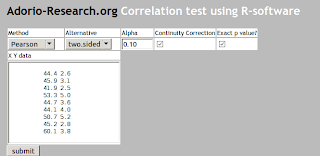There is no reason why anyone interested in statistical computing will not choose R software, unless they are already wedded to existing software from their school days, or the choice was already made for them by their companies or their professors!. R boasts the most number of libraries and is open source and best of all FREE!
It takes time to master the syntax and we suggest that readers should try to download and test the R software in their machine if they had not done so.
In this post, we shall describe our online solver for testing correlation between two variables X and Y.
The solver is mainly a web interface to the cor.test function available in R. This function has the following spec for input arguments:
cor.test(x, y,
alternative = c("two.sided", "less", "greater"),
method = c("pearson", "kendall", "spearman"),
exact = NULL, conf.level = 0.95, continuity = FALSE, ...)
Here is how our solver for correlation test looks like at the moment.
When the user clicks on the submit button, the solver will call the R software, grabs its output, and print the results:
0001 > x <- c(44.4,45.9,41.9,53.3,44.7,44.1,50.7,45.2,60.1)
0002 > y <- c(2.6,3.1,2.5,5.0,3.6,4.0,5.2,2.8,3.8)
0003 >
0004 > cor.test(x,y, alternative="two.sided", method="pearson",conf.level=0.9,exact=TRUE, continuity=TRUE)
0005
0006 Pearson's product-moment correlation
0007
0008 data: x and y
0009 t = 1.8411, df = 7, p-value = 0.1082
0010 alternative hypothesis: true correlation is not equal to 0
0011 90 percent confidence interval:
0012 -0.02223023 0.86697863
0013 sample estimates:
0014 cor
0015 0.5711816
0016
0017 >
The printed p-value .1082 tells us not to reject the Null hypothesis that the correlation between
x and y is zero.
We will a scattergraph to the solver in the future.
Here is our interface code for the correlation test.
__version__ = "0.0.2"
__catalog__ = "TEST-STAT-0036"
__date__ = "2011.02.14"
__author__ = "E.P. Adorio"
from qp.fill.form import Form, SingleSelectWidget, RadiobuttonsWidget, TextWidget, StringWidget, CheckboxWidget
from qp.sites.extreme.lib.uicommon import renderheader, renderfooter, processheader, processfooter
from math import sqrt
from qp.sites.extreme.lib.webutils import vecRead
from qp.sites.extreme.lib import webutils
from qp.fill.directory import Directory
from qp.pub.common import header, footer, page, redirect
from qp.fill.css import BASIC_FORM_CSS
from qp.sites.extreme.lib.webutils import vecRead, matRead, matReadByColumn, runRcode
from qp.sites.extreme.lib.qpyutils import printRlines, showLogo
from scipy import stats
import time
from scipy import stats
import copy
import math
def getGrFile(grType):
grfile = GraphicsFile("%s" % grType)
barefile = grfile.split(str("/"))[-1]
return grfile, barefile
def getformDict(form):
D={}
for field in form.get_all_widgets():
D[field.name] = form.get(field.name)
return D
def asColumns(S, ncolumns):
"""
Args:
ncolumns is number of columns.
S is a string containing a space delimited columns of values.
Return value
a list consisting of the columns of S.
"""
columns = [[] for i in range(ncolumns)]
for i, v in enumerate(S.split()):
columns[i % ncolumns].append( v)
return columns
def asRvector(x):
"""
Arg
x - Python string array.
Return value
an R vector as a string c(v1,....vn)
"""
S = "c("
for v in x:
S += str(v) + ","
S += ")"
return S.replace(",)", ")")
def SolveProblem(form):
D = getformDict(form)
x, y = asColumns(D["pairedSample"], 2)
alpha = float(D["alpha"])
method = D["method"]
alternative = D["alternative"]
cont = D["continuity_correction"]
exact = D["exact"]
exact = "TRUE" if exact else "FALSE"
cont = "TRUE" if cont else "FALSE"
xstr = "x <- " + asRvector(x)+"\n"
ystr = "y <- " + asRvector(y)+"\n"
Rcode =xstr + ystr
conflevel = 1-alpha
Rcode += """
cor.test(x,y, alternative="%s", method="%s",conf.level=%s,exact=%s, continuity=%s)
""" %(alternative, method,conflevel, exact, cont)
# create the R command.
Rcode = Rcode.replace(",)", ")")
return runRcode(Rcode)
class CorrTestPage(Directory):
def get_exports(self):
yield ('', 'index', 'Correlation test for Paired Data', "R stat software corr.test for Correlation")
def index[html](self):
form = Form(enctype = "multipart/form-data")
form.add(CheckboxWidget, name = "continuity_correction", \
value = True,
)
form.add(CheckboxWidget, name = "exact", \
value = True,
)
form.add(TextWidget, name = "pairedSample", \
rows = "10", cols = "30", value="""
44.4 2.6
45.9 3.1
41.9 2.5
53.3 5.0
44.7 3.6
44.1 4.0
50.7 5.2
45.2 2.8
60.1 3.8
"""
)
form.add(StringWidget, name = "alpha", size = 5, value = "0.10")
form.add(SingleSelectWidget, name="alternative", options=[
("two.sided", "two.sided"),
("less", "less"),
("greater", "greater")])
form.add(SingleSelectWidget, name="method", options=[
("pearson", "Pearson"),
("kendall", "Kendall"),
("spearman", "Spearman")])
form.add_hidden("time", value = time.time())
form.add_submit("submit", "submit")
def render [html] ():
renderheader("Correlation test using R-software")
pairedSample = form.get_widget("pairedSample")
alpha = form.get_widget("alpha")
exact = form.get_widget("exact")
method = form.get_widget("method")
alternative = form.get_widget("alternative")
cont = form.get_widget("continuity_correction")
"""
| Method | Alternative | Alpha | Continuity Correction | Exact p value? |
| %s | %s | %s | %s | %s |
| X Y data |
| %s |
""" %( method.render(), alternative.render(), alpha.render(),cont.render(), exact.render(), pairedSample.render())
renderfooter(form, __version__, __catalog__, __author__)
if not form.is_submitted():
return page('CorrTestPage', render(), style= BASIC_FORM_CSS)
def process [html] ():
processheader("Correlation test using R software corr.test() function")
calctime_start = time.time()
if True:
flag, output = SolveProblem(form)
printRlines(output)
if 0:
for widget in form.get_all_widgets():
"
| %s | %s |
" % (widget.name, widget.value)
processfooter(form, calctime_start, "./", "./stest_t1samp")
process()


